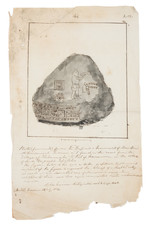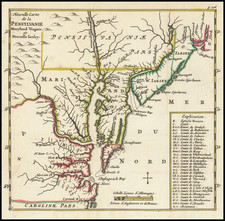Early Natives in the New Netherlands
This woodcut depicts two native Americans of the New Netherlands region. The accompanying text provides a detailed description of the lifestyle, culture, and practices of the indigenous peoples of the region.
The image appeared in Happel's Thesaurus Exoticorum, published in Hamburg in 1688. The text below translates as follows:
"In the northern part of America to the east lies the large district which the Dutch, who were mostly once masters of it, called New Netherlands. It is located between the 40th and 45th degree of northern latitude and between the 299th and 305th degree of longitude. The land has a climate like Italy's, with beautiful water, hearty trees, and crops, particularly good wine, metals, various animals, especially a kind of unicorn, which are very wild.
The inhabitants are well-formed, drink water, and eat fish and meat. They eat when they're hungry and drink when they're thirsty. Regarding clothing, the women adorn themselves more than the men. Even though it gets very cold in the winter, they usually go naked until they are 13 years old. Only the modesty of the young girls is covered. They all wear a belt around their waists made of snail shells, whale bones, and down feathers. The men wear a piece of leather, fur, or cloth between their legs that is half an ell wide and nine-quarters long. So, a rectangular piece hangs over the buttocks, and another over the stomach. The women wear an underskirt interwoven with snail shells, sometimes costing up to three hundred guilders, which extends past their knees. Over their naked bodies, they wear a deer hide with tassels that dangle around.
Both men and women's top clothing is a long, wide strip fastened on the right shoulder with a button and around the waist with a band. They use this strip as a nightgown. The women tie their hair back in a ponytail and wear a square cap or headcover interwoven with snail shells. They adorn their headbands with the same material. Around their necks and arms, they wear cords made of the same snail shells; some also wear them around their waists. Before the Dutch settled here, their shoes and stockings were made of deer and seal skins. Some also wore shoes made of wicker, but later they began to wear Dutch shoes and stockings. The men paint their faces with various colors. The women only put on a black spot here and there. Both are very serious.
Their houses are mostly built in the same manner and are about twenty feet in width, although some are longer and others shorter. The construction goes as follows: They stick shaved stakes made from walnut trees into the ground around the marked circumference of the house. At the top, they bend the tips in the manner of a corridor, tying several slats over the bent stakes. Afterward, the walls and the roof are covered with bark from alders, ash trees, and chestnut trees."
Eberhard Werner Happel (1647–1690) was a German author of scientific and historical works. The son of a reformist Lutheran minister, he studied law, mathematics, and natural sciences in Marburg, Germany, from the 1660s to 1680s, though due to financial issues he never finished his formal education. He also tutored aristocratic families in Hessen and Hamburg during this time. Around 1680 he devoted himself to writing, publishing several works of historical fiction. He also published several historical and scientific almanacs, the most famous of which was Historia Moderna Europae, which covered recent European political history and included detailed maps and engravings. His most famous scientific work was Gröste Denkwürdigkeiten der Welt: Oder, So genannte “relationes curiosae”, which contained one of the most important early discussions of oceanographic phenomena. In later years Happel continued to be a successful and widely read author. He died in Hamburg at age 42, survived by his wife, Margarita, and four children.










![(Colonial New York) [Deed of Partition of a Tract of 10,200 Acres of Lands to the Eastward of Fort Edward in Charlotte County]](https://storage.googleapis.com/raremaps/img/small/93927.jpg)

![Southeastern New York [with inset] Vicinity of New York](https://storage.googleapis.com/raremaps/img/small/101125.jpg)
![[Columbus Discovering the Americas]](https://storage.googleapis.com/raremaps/img/small/82203.jpg)
![(Aztec Tribute List) [Original watercolor showing tribute items paid to the Aztecs by subject towns] Mendoza Col. part 1s Lorenzana, Aglio 1, Vol 22...](https://storage.googleapis.com/raremaps/img/small/102321.jpg)